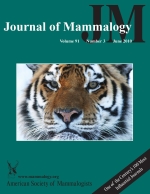Jaguars (Panthera onca) often prey on livestock, resulting in conflicts with humans. To date, kill rates and predation patterns by jaguars have not been well documented. We studied the foraging ecology of jaguars in an area with both livestock and native prey and documented kill rates, characteristics of prey killed, patterns of predation, and the influence of prey size on the duration at kill sites and the time interval between kills. Between October 2001 and April 2004 we monitored 10 jaguars equipped with global positioning system (GPS) collars. We collected 11,787 GPS locations and identified 1,105 clusters of locations as sites of concentrated use (e.g., kill sites, bed sites, and dens). Of these, we found prey remains at 415 kill sites and documented 438 prey items. Kills were composed of 31.7% cattle (9.8% adults and 21.9% calves), 24.4% caiman (Caiman crocodilus yacare), 21.0% peccaries (mostly Tayassu pecari), 4.1% feral hogs (Sus scrofa), 3.9% marsh deer (Blastocerus dichotomus), 3.2% giant anteaters (Myrmecophaga tridactyla), 2.0% capybaras (Hydrochoeris hydrochaeris), 1.6% brocket deer (Mazama americana and M. gouazoubira), and other avian, mammalian, and reptilian species. Individual jaguars differed in the proportion of each species they killed and the proportion of native prey versus cattle. Although all 10 cats killed cattle, 5 killed a high proportion of cattle (>35% of kills), and 3 killed few cattle (<15%). Males (27%) and females (35%) killed cattle in similar proportions. In contrast, male jaguars killed a higher proportion of peccaries than did females, and female jaguars killed more caiman than did males. The mean kill rate for all jaguars was 4.3 days ± 4.4 SD between known consecutive kills. The time interval to the next subsequent kill by jaguars increased with increasing prey size. Jaguars also increased the length of time at a carcass as prey size increased. Jaguar kill rates on peccaries steadily increased over the 4-year study. In contrast, kill rates on cattle decreased during the same period. Rainfall, and subsequent water levels on the Pantanal, was the main driver of seasonal kill rates by jaguars on cattle and caiman. As water levels increased, predation on caiman increased as caiman became more distributed throughout the landscape. Conversely, as water levels fell, caiman became less plentiful, and cattle were moved out into pastures thereby increasing their availability to more jaguars.
How to translate text using browser tools
16 June 2010
Kill rates and predation patterns of jaguars (Panthera onca) in the southern Pantanal, Brazil
Sandra M. C. Cavalcanti,
Eric M. Gese
ACCESS THE FULL ARTICLE

Journal of Mammalogy
Vol. 91 • No. 3
June 2010
Vol. 91 • No. 3
June 2010




